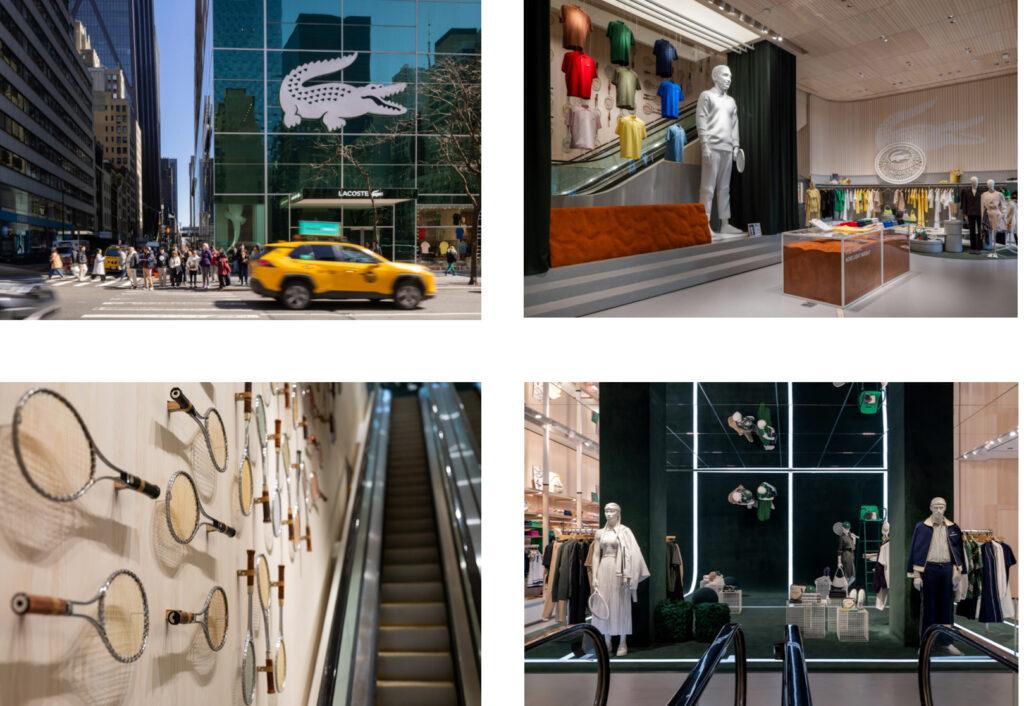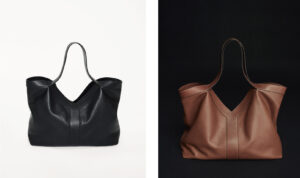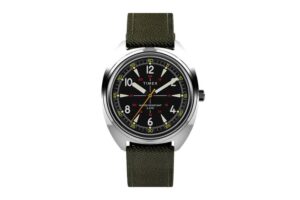From René’s legacy to modern retail innovation, Lacoste’s grand opening on New York’s Fifth Avenue is a masterstroke of brand identity, spatial storytelling, and cultural fluency.
An Icon Takes Manhattan
The opening of Lacoste’s new flagship store on Fifth Avenue in New York City is more than a retail expansion—it’s a symbolic return to the cultural conversation. In a city where fashion lives in motion, on pavement, in storefronts and stories, Lacoste’s decision to open a 10,000-square-foot flagship at 575 Fifth Avenue affirms the brand’s commitment to shaping the future while staying rooted in legacy.
As a global ambassador of sport-infused elegance, Lacoste has always moved between worlds: tennis courts and art galleries, country clubs and city streets. This new flagship is no exception. With contemporary retail architecture, immersive digital elements, and a curated homage to René Lacoste’s origin story, the Fifth Avenue store unfolds as a temple of tennis and tailoring—a place where the crocodile once again becomes a cultural force.
Architecture as Brand Language
Designed with clarity and immersion in mind, the space is a metaphor in motion. At its pithy lies a deconstructed tennis court, not merely as a visual motif but as an organizing principle. The white lines, green colorways, and textured surfaces hint at the brand’s athletic past, while modern materials and open floor plans speak to Lacoste’s future-forward ethos.
Every design gesture is purposeful. Natural wood, brushed metal, and polished concrete intersect to create an interior that is both warm and minimal. The effect is tactile without being distracting—a backdrop for expression, not a distraction from it. The ceiling mirrors the rhythm of a serve; the lighting mimics the arc of a volley; the layout breathes like an open court.
The store’s 10,000-square-foot sprawl never feels overwhelming. Instead, it behaves like a gallery: each section showcases a different chapter of Lacoste’s multidimensional identity. From classic polos to contemporary collaborations, from performance footwear to archival nods, the space curates rather than crowds.
Fifth Avenue: Lacoste’s American Love Affair
Choosing Fifth Avenue was no coincidence. In the crowded competition for cultural relevance, location still matters—and few streets are as storied as this one. Fifth Avenue is not just real estate. It is reputation. It is ritual. For Lacoste, this address signals both aspiration and arrival: a brand that once symbolized European refinement now claims a place at the midst of American retail power.
The decision to plant roots here is also a reflection of Lacoste’s growing resonance with U.S. audiences. Long popular in tennis circles and preppy enclaves, the brand has recently expanded into streetwear, youth culture, and collaborative ventures. With its Fifth Avenue flagship, Lacoste makes it clear: it isn’t following trends—it’s shaping them.
The Polo Wall: A Grid of Possibilities
Among the store’s most striking features is the Polo Wall—a chromatic celebration of the Lacoste polo shirt, the garment that started it all. Here, dozens of polos are neatly arranged by color, like swatches in a design studio or entries in a Pantone index. This is more than merchandising; it is myth-making through fabric.
Each polo, marked by the iconic crocodile, is a portal into Lacoste’s past. Born in 1933 from René Lacoste’s desire for a more functional tennis shirt, the polo has since become one of the most recognizable items in fashion history. At the Fifth Avenue flagship, it is not just sold—it is honored.
Customers can also customize their polos through a digital interface, selecting color combinations and monograms in real time. This interactive experience reinforces the brand’s belief in personal style as athleticism of the self.
Collabs and Courtside: The Cultural Gallery
Lacoste’s flagship also plays host to its more experimental chapters, with a rotating selection of its most notable collaborations. Expect drops with Novak Djokovic, Daniil Medvedev, and fashion-forward capsules from partners like Ricky Regal (Bruno Mars) and Highsnobiety.
These areas serve dual purposes: first, they showcase Lacoste’s range—from high-performance sportswear to high-fashion play—and second, they position the brand in dialogue with contemporary creators. The Fifth Avenue store becomes a living archive of Lacoste’s expanding relevance.
Screens throughout the store project campaign films, athlete highlights, and archival tennis footage, transforming passive retail into a dynamic storytelling environment.
Sustainability Meets Sport
In tune with global shifts toward eco-conscious retail, the flagship integrates a number of sustainability-forward features. LED lighting, upcycled materials in shelving, and minimal packaging zones reflect Lacoste’s broader commitment to reducing its environmental footprint. The store also houses a section for Lacoste Loop Polos, which are created from recycled cotton and feature circular economy messaging.
This is Lacoste’s attempt not only to future-proof its brand, but to model responsibility in a retail industry grappling with waste and excess. The Fifth Avenue flagship suggests a vision of style that is both circular and timeless.
Digital & Physical: Lacoste’s Omni-Retail Strategy
Understanding the new consumer journey, Lacoste blends online and offline retail seamlessly. In-store tablets, AR fitting rooms, and mobile checkout make for a frictionless experience. A “Style Studio” near the back of the store lets customers browse digital lookbooks, style recommendations, and even book private shopping appointments.
Importantly, the flagship doesn’t overwhelm with tech for tech’s sake. Instead, every digital element enhances the tactile. The result is an environment where the ritual of trying on clothes is not replaced, but enriched.
Lacoste as Global Cultural Code
Beyond the clothes, Lacoste is evolving into a global cultural signifier. From French tennis legend to hip-hop mainstay, from preppy mainstay to Gen Z favorite, the brand wears many hats—or polos. Its recent campaigns have featured not just athletes but poets, DJs, dancers, and young creatives from around the world. This flagship becomes a portal to that plural identity.
The flagship also marks a return to emotion in retail. Where so many fashion brands have embraced blank minimalism, Lacoste doubles down on heritage, metaphor, and feeling. The crocodile is not just a logo—it’s a mythical beast that continues to evolve, shedding skin, growing bolder.
The Opening Moment: Community and Ceremony
To celebrate the opening, Lacoste held an invite-only launch event attended by brand ambassadors, local designers, influencers, and longtime fans. The evening featured live music, screen-printed tote giveaways, limited edition polos, and a short documentary screening on René Lacoste’s legacy.
The event reinforced what the space represents: not just commerce, but community. The Fifth Avenue store doesn’t just sell—it welcomes. It is a place to try on, try out, and belong.
Impression
In opening its doors on Fifth Avenue, Lacoste has done more than secure square footage. It has redrawn its court lines. It has built a new arena—not of competition, but of convergence: sport and style, heritage and innovation, legacy and next.
The flagship is both monument and movement. It invites customers to play, to dress, to question, to remember. Most of all, it reaffirms Lacoste’s belief that fashion is a form of discipline—and the best athletes, like the best brands, evolve through form.
This isn’t just Lacoste’s store. It’s its new serve.
No comments yet.







